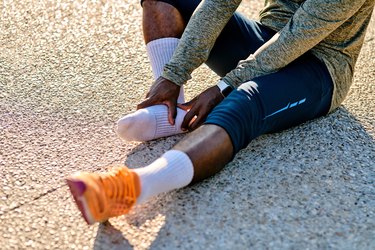
To say that plantar fasciitis is a frustrating, nagging injury would be a major understatement. The condition, which causes pain and inflammation in the bottom of your foot, is a common running injury. But even if you're not a runner, plantar fasciitis can majorly disrupt your day-to-day.
"The plantar fascia is a thick band of connective tissue along the bottom of your foot," Luke Greenberg, DPT, co-owner of MOTIV in New York, says. "When that tissue is inflamed, it can become really painful, and this is usually a stress tolerance issue or caused by overuse."
Video of the Day
Plantar fasciitis pain is predominately felt at the base of the heel (it's not a pain in the arch of the foot), and is often described as an ache or similar to the pain associated with a bruise — but depending on the severity of your case, it could feel more sharp.
More often than not, increased movement helps to alleviate acute plantar pain. For instance: First thing in the morning, your pain may be at a level 8 and result in some limping. Within 10 to 20 minutes of movement, however, the pain could decrease. It's also common that the pain goes away with rest.
Just how prevelant is it? Approximately 1 in 10 people will experience this problem in their lifetime, according to a June 2019 article in American Family Physician. The good news? There are a slew of different plantar fasciitis exercises and stretches that you can do to help alleviate pain — and work toward fewer flare-ups in the future.
8 Exercises to Treat Plantar Fasciitis
These plantar fasciitis exercises are popular because they target the muscles that frequently trigger the nagging pain. In other words, your plantar pain could be a result of tight calves or hips, weak glutes or even a lack of core strength.
It's important to consult with an expert when experiencing this issue, advises Greenberg. "Everyone is different, and the goal is to work with someone who can help you figure out why it happened," he says. "In other words, how you're using your body that resulted in that inflammation in your foot, and address the issue at the root cause."
Greenberg divides the recommended movements to treat plantar fasciitis up into three phases. The first phase aims to reduce inflammation, the second phase is rebuilding base strength in the area and the third phase is working on stress tolerance while building load. Remember: These are just a starting point, and that's another big reason why it's essential to seek out a physical therapist or physician who can evaluate your specific injury.
"If you're working with a physical therapist for a few months and not seeing any relief, that's a good indicator that it's time to see a physician for a second opinion," Greenberg says.
1. Ankle Controlled Articular Rotation (CAR)
- Start in a seated position with your left leg bent with left foot on the floor. Cross your right foot across your left knee.
- Bring your right toes up.
- Rotate the bottom of your foot inward, then point your toes down and finish with rotating the bottom of your foot outward.
2. Heel Mobilization
- Start sitting on your knees with a block or book behind you.
- Rest the top of the your feet on the block.
- Lean backward, and press the meat of your heel outward for 10 seconds.
- Gently release; repeat for 4 rounds.
3. Heel Hover Isometric Split Squat
- Stand with your feet hip-width apart in front of a block or step.
- Step the toes of your your right foot onto the block or step. Step the left foot back, and lower into a lunge, keeping your torso upright and your left knee off the ground in a hover.
- Hold for 20 to 30 seconds, with most of the weight in your front foot.
4. Eccentric Calf Raise
- Place your feet on the ground or elevated surface, about hip-distance apart, with your knees and toes pointing straight ahead. Your feet should be in line with your ankles and your weight distributed evenly.
- Extend your ankles and rise up on the toes, flexing your calf muscles.
- Slowly lower down from the top of your calf raise for 5 counts while maintaining control.
5. Single-Leg Hop
- Stand with your feet hip-width apart. Lift your left leg up to balance on your right foot.
- Hinge forward at your hips and slightly bend your right knee, bringing your left arm forward and right arm back.
- Explosively jump up, switching your arms and using that momentum to propel you upward.
- Land with control. Once you've found your balance, repeat for 30 seconds.
6. Single-Leg Romanian Deadlift to Knee Drive With Kettlebell
- Hold a medium-weight kettlebell with both hands at your chest (goblet position). Balance on your right foot.
- Hinge your hips backward to do the deadlift, lowering the kettlebell toward the floor while holding it by the handle and lifting your left leg up behind you.
- In one movement, thrust your hip forward and drive the kettlebell up to the goblet position. Simultaneously drive your left knee toward your chest.
- Return to start. Repeat for 30 seconds.
Tip
To make this move easier, break it into segments. Try the single-leg Romanian deadlift portion on its own with your bodyweight, then do the knee drive portion. As you get stronger, you can add weight and combine it into one fluid motion.
7. Single-Leg Wall Pogo
- Lie on your back, and put your right foot on the wall. Hover your left foot next to it.
- Bend your knees more than 90 degrees and push through your right toes to elevate the heel off the wall.
- Start slowly then increase your pace: Begin with a calf raise, then slowly begin to jump the right foot off of the wall.
- Once you feel like you have control, transition into a faster pace.
- "Pogo" up and down for 30 seconds before switching sides.
8. Switch Jumps on Toes
- Stand in a staggered stance with your hands on your hips. Rise onto your toes.
- Jump, alternating your feet in the air before landing back on your toes. (Imagine you’re wearing high heels and your heels don’t touch the floor.)
- Continue for 30 seconds.
How Long Does Plantar Fasciitis Take to Heal?
While there are no guarantees, Greenberg says that someone can struggle with plantar fasciitis for 3 to 12 months on average. But if you're incorporating these exercises and seeking out assistance, it's common that you'll be on the shorter end of that range, he adds.
"This isn't something that goes away on its own, unfortunately," Greenberg says. "Time and patience will make a world of difference."
Other Plantar Fasciitis Treatments
In addition to the exercises listed above, Greenberg also recommends speaking to an expert about other helpful tools and natural remedies.
A specialist may recommend the use of pain relievers (NSAIDS like Advil, ibuprofen or Motrin) or orthotic inserts that can help correct iffy movement patterns.
Headed to the podiatrist? Depending on the severity of your case, they may recommend you try laser treatments that work to lessen inflammation, shock wave therapy or a series of injections (either platelet-rich plasma [PRP] or cortisone).
Just be careful about using something like a cortisone shot as a temporary fix, cautions Greenberg. "There's a lot of research that cortisone shots can degrade the quality of connective tissue, especially with repeated injections," he says. "It's a sort of last resort option at this point if you're not successful with other management techniques."
What's more, PRP injections were found to be more effective than steroid injections for treating plantar fasciitis in a March 2023 study in BMC Musculoskeletal Disorders.
" [And] even if you get injections, you still have to rewire the way you move and stress your foot," Greenberg says.
Was this article helpful?
150 Characters Max
0/150
Thank you for sharing!
Thank you for your feedback!


